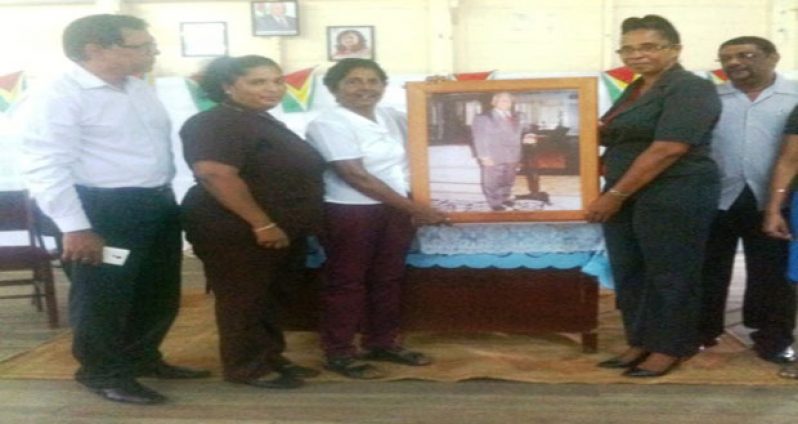STUDENTS attending two schools previously attended by the late President Dr. Cheddi Jagan were recently encouraged to follow the work of the former Head of State, and to emulate him in whatever way possible. As part of a series of events being held in observance of the 18th death anniversary of the late President, his portraits have been mounted at Rose Hall Primary, and Port Mourant Scott Schools, along the Corentyne coast in Berbice. Dr. Cheddi Jagan died on March 6, 1997, in Washington, D.C., United States of America.
In an effort to keep his legacy alive, the Cheddi Jagan Research Centre mounted his portraits at the two learning institutions, where the now deceased had received his primary education.
At a simple ceremony recently, Dr Jagan’s sibling Ms, Debra Jagan -Fries, recounted to her audience the childhood days of her oldest brother.
“After returning to his home village of Port Mourant, he could not find a job, so, Cheddi, took up a friend’s advice and went to the United States. A steamer [boat] fare was acquired after our father sold all of the family’s movable assets. While studying, Jagan did odd jobs to upkeep himself. His first job was that of tailoring.”
According to Ms Jagan-Fries, on his return to Guyana, she was given her first pair of shoes at the age of 10.
“He was a wonderful brother, for what he did was to educate all 11 of us. It was not easy. He had to work very hard. So you can achieve whatever you want but you have to work hard to get it,” Jagan-Fries told students at the Port Mourant Scott Primary School.
Further, she informed the pupils of how hard she worked, and noted, that in her younger days, she cut grass and used her feet to mash paddy in order to make a living.
The students also learnt of Dr. Jagan from an international perspective and as a leader of the country.
Administrator of the Cheddi Jagan Research Centre, Indra Chandarpal, noted that the same life those students were experiencing is the same one that the late Dr. Cheddi Jagan had. “The difference is that during his time the conditions were much harder that they are today.”
She said in order to succeed, the students must have a vision and must work hard.
It was after his death that the Cheddi Jagan Research Centre was established at The Red House through the efforts of his wife, the late Janet Jagan.
Chandarpal noted that it is the duty of the People’s Progressive Party (PPP) which was formed by Dr. Jagan, to ensure that his legacy lives on.
The portrait of Dr. Jagan should serve as a constant reminder to all you young children of the life he lived, so that you can use it as a role model, to carve your own destiny.”
In both schools the portraits were mounted in the school’s auditorium.
The late Cheddi Bharrat Jagan is undoubtedly a national hero who emerged from the bound-yard of a Corentyne sugar plantation, being the son of East Indian indentured labourers, and ascended to the highest seat in Government, namely, the President of the Cooperative Republic of Guyana.
Prior to his ascension, he had experienced the wrath of the Anglo-American alliance and local reactionaries in the 1950s and 1960s. With remarkable patience and persistence, Jagan endured 28 years in the political wilderness while never once doubting the righteousness of his cause and with the firm belief that time and history were on his side. With a wave of new consciousness and vigorous steps for the restoration of democracy, there came the inevitable vindication of this great son of Guyana, Cheddi Jagan, as the legitimate representative of the popular will of the people when in 1992 he swept the polls and emerged President.



.jpg)









